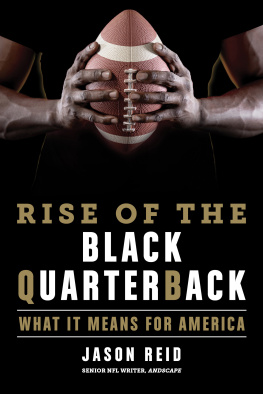Penguin supports copyright. Copyright fuels creativity, encourages diverse voices, promotes free speech, and creates a vibrant culture. Thank you for buying an authorized edition of this book and for complying with copyright laws by not reproducing, scanning, or distributing any part of it in any form without permission. You are supporting writers and allowing Penguin to continue to publish books for every reader.
PENGUIN is a registered trademark and PENGUIN WORKSHOP is a trademark of Penguin Books Ltd. WHO HQ & Design is a registered trademark of Penguin Random House LLC.
Visit us online at penguinrandomhouse.com.
Library of Congress Cataloging-in-Publication Data is available.
The publisher does not have any control over and does not assume any responsibility for author or third-party websites or their content.
For my brothers, LRW and CAWIII, who love football, and who I hope will always Know Your RightsLW
Who Is Colin Kaepernick?
As the United States national anthem began playing on August 14, 2016, professional football player Colin Kaepernick remained seated on the bench while his teammates stood and placed their hands over their hearts.
Although it is tradition, its not a requirement to play the national anthem before sporting events. Playing it has long been considered a way for United States citizens to show their respect and love for their country. However, Colin Kaepernick didnt feel much love or respect for his country in that moment. A month earlier, two Black menAlton Sterling and Philando Castilehad been unfairly targeted and killed by police officers in Minnesota and Louisiana. And no officers were ever found guilty of committing a crime.
Colin refused to stand for the pregame playing of the national anthem again on August 20 for the same reason. However, no one noticed Colin sitting out because he wasnt wearing his football uniform. He had been injured and wasnt going to play in the first two preseason games.
Things changed on August 26, 2016. Colin was due to play for the first time that season against the Green Bay Packers and had suited up in his game jersey. While the anthem played, Colin sat on the bench. A reporter named Jennifer Lee Chan tweeted out a photo of the football field during the anthem. Twitter users noticed Colin Kaepernick sitting on the bench. During the game, social media users all over the country wondered why Colin remained seated. After the game, Colin told reporters that he remained seated to protest the injustices that are happening in America.
Two days later, Colin gave more details during another interview with the press, where he explained that his protest was about giving a voice to people who werent being heard. He said people were dying because the United States wasnt keeping their promise to provide freedom, justice, and liberty to all, citing the experiences of Black people. He told the mediaand the worldthat until he saw change, he would not stand up for the national anthem.
Many people became angry with Colins decision to sit out during the national anthem. They felt like Colin was disrespecting the American flag, the country, and the soldiers who fought for the country and the American people.
Colin said this wasnt true. He said that he respected the American soldiers.
Colin ended his speech by saying he wouldnt stop protesting until police brutality ends. I am not going to stand up to show pride in a flag for a country that oppresses Black people and people of color.
On August 30, Nate Boyer, a former soldier from the Green Beret unit of the United States Army, wrote Colin Kaepernick an open letter a letter that is not private but available for the public to read as well. In Nates letter, he told Colin that although he was initially upset when the San Francisco 49ers quarterback sat during the anthem, he is now trying to listen and understand. In a later meeting with Colin, Nate offered a better way to protest, without disrespecting the soldiers. He said that soldiers take a knee in front of their fallen brothers graves to show respect. Colin agreed to compromise and protest this way.
In the final preseason game on September 1, 2016, Colin suited up in his football uniform to play against the San Diego Chargers. Colin Kaepernick, along with his teammate defensive back Eric Reid, took a knee while the national anthem played.
Eric Reid and Colin Kaepernick
Colin Kaepernick was born on November 3, 1987, in Milwaukee, Wisconsin. Colins birth father had left shortly after his birth mother became pregnant with Colin. Colins birth mother, nineteen-year-old Heidi, didnt know how she would be able to take care of a new baby. So Heidi placed Colin up for adoption when he was five weeks old. A few towns over, in Fond du Lac, Wisconsin, a couple were looking to adopt a baby.
Rick and Teresa Kaepernick already had a son and a daughter. But their last two sons had died shortly after birth. After grieving, Rick and Teresa decided to adopt their next baby. When they met Colin, the couple fell in love and brought him home to live with them. Teresa called Colin her perfect child.
But everything wasnt perfect. Rick, Teresa, and their birth children were all white. Colin was biracial; his birth mother was white, and his birth father was Black. Having a different skin color than other family members can be difficult for kids who are a different race than their adoptive family. But Colins parents discussed his adoption with him early on. They frequently reminded their young son that his darker skin color reflected both his African American and white heritageall the parts of his background that made him Colin.
Rick and Teresa never treated Colin like he was white. They acknowledged his mixed-race background and made sure they listened to his requests for things that honored his Black heritage.
When Colin was four years old, the Kaepernick family moved to Turlock, California. In Fond du Lac, almost everyone had been white. Although more races were represented in Turlock, most of the people were still white. It was in this new town that Colin and his family began experiencing racismor mistreatment based on a persons race or ethnic groupfrom their neighbors and strangers. When playmates saw Colins brown skin compared to his parents white skin, they would ask, Whos your real mother? Children and adults sometimes stared as Colin walked alongside his family.



















